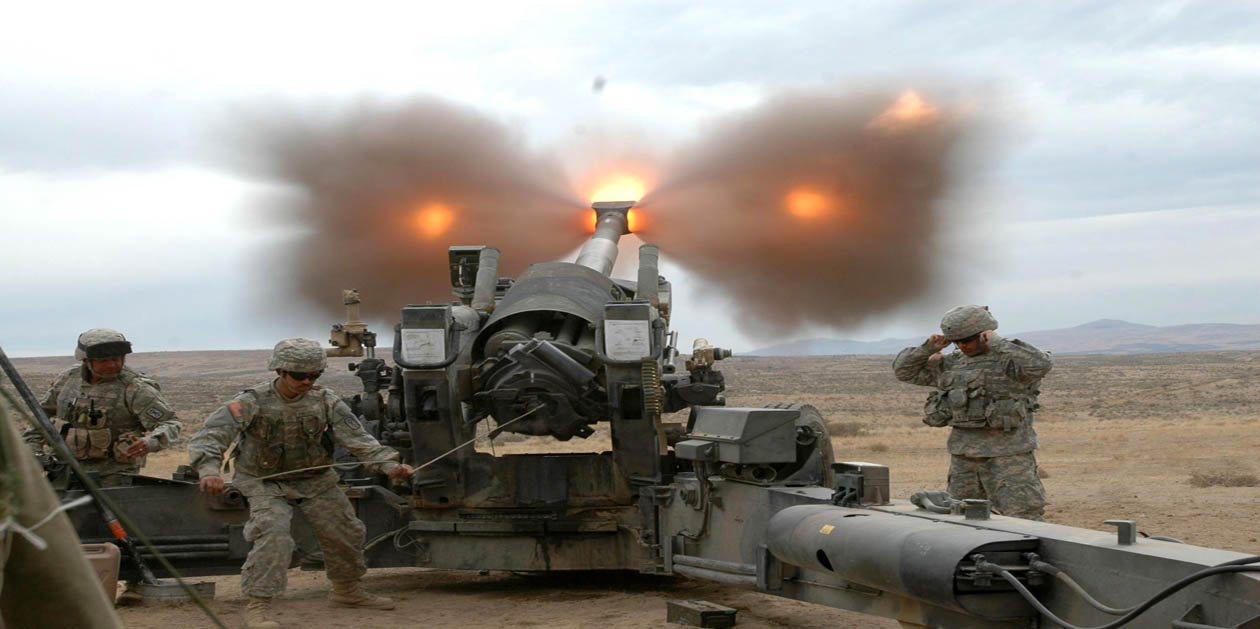Quantum Jump- Artillery Modernisation
The Indian Artillery is currently in a Network Centric Warfare (NCW) Environment and has to provide Surveillance and Reconnaissance resulting in Target Acquisition, which would lead to engagement, and which needs to be monitored to undertake Post Strike Damage Assessment and ensure that the target is destroyed. In NCW, Artillery shapes the battle field, degrades enemy’s war waging capability, destroys his field defences, communication sites, logistics echelons thereby paralysing him and thus accomplishing our mission. The Regiment of Artillery is currently equipped with a variety of surveillance devices, Guns, Mortars, Rockets and Missiles. The surveillance devices are a part of the Surveillance and Target Acquisition (SATA) Regiments. The devices currently held comprise the Unmanned Aerial Vehicles (UAVs) which are of four types. They are the Medium Altitude Long Endurance (MALE), Heron UAV and Short Range UAVs Searcher MK I, Searcher Mk II as also indigenously built Nishant. These UAVs have been operationally optimised and they are an extremely useful tool of surveillance. Our current holdings are minimal and their numbers need to be enhanced. The Defence Research and Development Organisation (DRDO) is currently developing a MALE UAV Rustam which will possibly be inducted in the short term.
The SATA units are currently equipped with Medium Range Battlefield Surveillance Radars (MBFSR) and Weapon Locating Radars (WLR). The MBFSR currently held is the ELM 2140 which is able to detect tanks, vehicles and troops. They are held in minimal quantities and have been exploited by mobile masts. The WLR currently held is the ANTPQ-37 which has been optimised with a reasonable degree of success. Further, SATA units are equipped with Long Range Reconnaissance and Observation System (LORROS). This equipment has excellent day and night surveillance capability and has proved its effectiveness in operational areas. The SATA units also have a passive weapon locating system known as Sound Ranging. The system currently held is old and needs to be replaced by state of the art equipment. Bharat Electronics in conjunction with DRDO has developed a Weapon Locating Radar which is undergoing evaluation of trials.
As regards Guns, the Regiment of Artillery is equipped with Field, Medium, Self Propelled, Light and Medium Regiments. Field Regiments possess either 105 mm Indian Field Gun / Light Field Gun or 122mm Field Howitzer. The Medium Regiments possess 130 mm Medium Gun, 155 mm Bofors Medium Gun (39 calibre) and a few regiments of Soltam Guns. The Self Propelled Regiments are equipped with 130 mm Catapult and the Light Regiments are equipped with 120 mm Mortars.
The Regiment also holds rockets and missiles. Rocket Regiments are equipped with 122 mm GRAD BM -21 rockets, 214mm Pinaka Rockets and 300 mm Smerch Rockets. The Missile Regiments are equipped with the Super Sonic Cruise Missile BrahMos which has a range of 290 km. Recently, India has joined the Missile Technology Control Regime which has resulted in trials for extending the range up to possibly 400 Km.
Recently, the Regiment has inducted six 155 mm (45calibre) Dhanush Gun systems manufactured by the Ordnance Factory Board. It is also reported that they have placed an indent for 114 of these Guns. This is to be followed by a further order of about 300 Guns. The Gun is designed, developed and made in India which enhances our indigenous capability of manufacturing state of the art equipment. Further, the equipment has undergone extensive evaluation trials and would attain a maximum range of about 38 Km.
The other Guns pertain to the 155 mm Ultra Light Howitzer (39 calibre) and the Self Propelled Gun K 9 Vajra (52 Calibre). The Ultra Light Howitzer (ULH) is manufactured by BAE Systems and is being procured by the Foreign Military Sales Route from the United States (US). The Letter of Acceptance (LOA) has been received and the process of induction would soon commence. While a few pieces would be obtained from the Original Equipment Manufacturer, the remaining would be made in India by Mahindra Defence. The Gun is extremely light and can be helilifted by a helicopter Chinook, CH 47 C which is being procured by the Indian Air Force. It is expected that 145 pieces would be added to the inventory. The K 9 Vajra is a Self-Propelled (SP) Gun is an indigenised version of a South Korean SP Gun which would be made in India by Larsen and Toubro Limited. The Gun would be utilised in the desert regions bordering our Western portion and would be the first SP Gun after the 105 mm Abbot and the 130 mm Catapult to be inducted into The Army. About 100 pieces would be the initial order. The contract has been signed and the Gun would be manufactured at the Larsen and Toubro plant at Talegaon, near Pune. Assistance will be provided by Samsung Techwin for the project.
This is a thundering moment for the Indian Artillery which has broken the glass ceiling and taken a Great Leap Forward in the field of modernisation. These three systems would make a Quantum difference to the Regiment of Artillery.
Status of Other Projects
There are numerous projects which are currently underway. The trials for the 155 mm (52 calibre) Towed Gun is completed. The Gun from Nexter France and Elbit in Israel are in the fray. A Committee of Experts has been set up to look into the issues observed as a result of the General Staff evaluation. Based on their recommendations, the future Towed Guns fate would be decided. Further, the DRDO, with the assistance of Bharat Forge have developed a prototype for the Advanced Towed Artillery Gun. Development firings carried out for this 155 mm (52 calibre) at Balasore has been well received. BrahMos has been successfully tested by the user in the Steep Dive Mode at Andaman and Nicobar Islands and the fourth Regiment which would be in the mountainous region would be inducted. Further it is creditable that the Bi-modular Charge System would soon be manufactured by Ordnance Factory Board.
Areas of Concern
There are few areas which the Regiment must attend. First is the 155 mm (52 calibre) Mounted Gun System. The Acceptance of Necessity (AON) for 814 of these Guns has lapsed. This Gun mounted on the prime mover has excellent mobility and the authorities must do their utmost to revive the Acceptance of Necessity and issue a Request for Proposal. The next issue is to find a suitable long range Rocket system of 80 to 90 Km for the mountains. The Common Gun Tower has been accepted after completion of all procedures. Currently, there are some aspects which need financial clearance for the project. Once these are settled, the induction of 100 Common Gun Towers would commence. This would solve the problems for all Gun Towing Vehicles. The Artillery must have Precision Guided Ammunition in its inventory. Currently a few rounds of Krasnopol ammunition are available. There is an urgent need to have Joint Venture projects come up in this field to ensure that we are able to acquire capability to make these weapons indigenously. The Artillery can only sustain itself through indigenous development. Effective steps must be taken by all agencies in this regard.
Conclusion
It is heartening to note that there has been a quantum jump in the induction of three Gun systems as also the Steep Dive BrahMos missiles for the mountains. There are Areas of Concern which the Regiment of Artillery must address appropriately to complete the modernisation process.
Image Source: https://s-media-cache-ak0.pinimg.com











Post new comment